Water is the lifeblood of any garden, but it’s also a precious resource that’s becoming increasingly scarce in many regions. Learning effective water-saving gardening practices isn’t just environmentally responsible—it’s becoming essential for maintaining beautiful, productive gardens in a changing climate.
Whether you’re gardening in a drought-prone area or simply want to reduce your environmental footprint, these water-conservation techniques will help you create a thriving garden while using significantly less water. The good news? Many of these practices also lead to healthier plants and lower water bills.
1. Mulching: Your First Line of Defense Against Water Loss
Mulching is perhaps the simplest yet most effective water-saving practice you can implement in your garden. A good layer of mulch acts as a protective barrier that significantly reduces evaporation from the soil surface.
Why Mulching Works
When soil is exposed to sun and wind, water evaporates quickly from its surface. Mulch creates a protective layer that shields the soil from these elements, keeping moisture where your plants need it—in the root zone. Studies show that proper mulching can reduce water needs by up to 30%.
How to Implement Effective Mulching
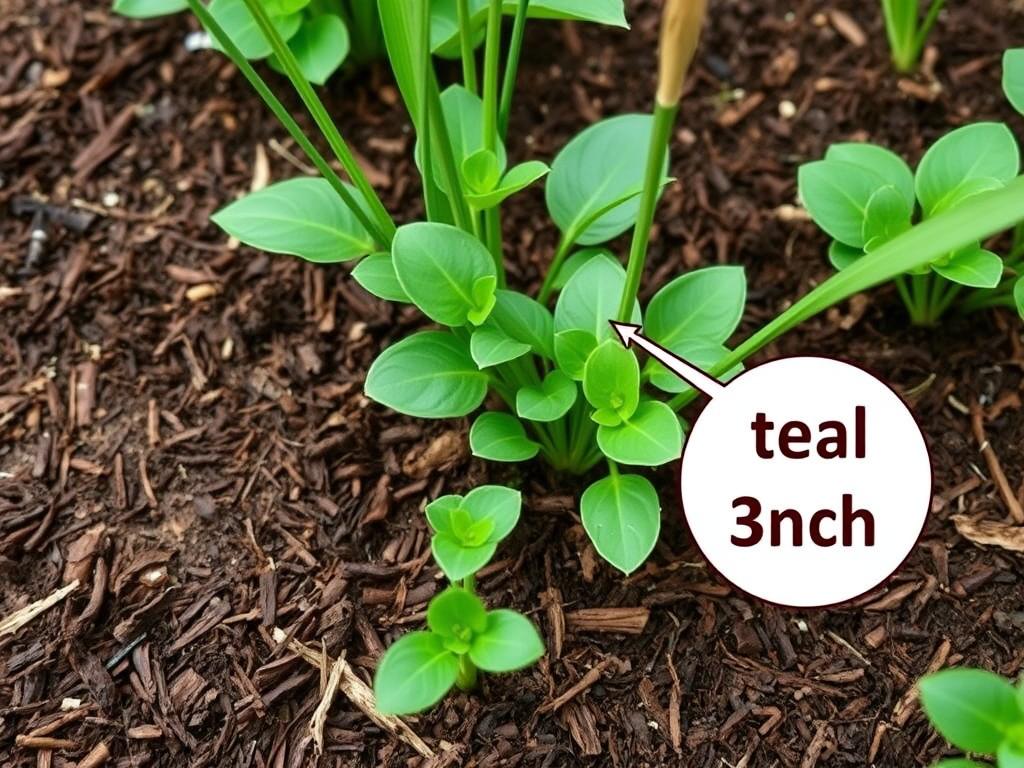
- Apply a 2-3 inch layer of mulch around plants, keeping it slightly away from stems and trunks
- Choose organic mulches like wood chips, straw, or compost for vegetable gardens and ornamentals
- For pathways and larger areas, consider inorganic mulches like gravel or stone
- Refresh mulch annually or when you notice significant decomposition
Pro Tip
In vegetable gardens, water the soil thoroughly before applying mulch. This initial deep watering, combined with the moisture-retaining properties of mulch, creates an ideal growing environment that requires less frequent irrigation.
2. Drip Irrigation: Precision Watering for Maximum Efficiency
Traditional sprinklers can waste up to 50% of water through evaporation and runoff. Drip irrigation delivers water directly to plant roots, dramatically improving efficiency.
Why Drip Irrigation Works
By delivering water slowly and directly to the root zone, drip irrigation minimizes evaporation and ensures that water goes exactly where plants need it. This targeted approach can reduce water usage by 30-50% compared to conventional watering methods.
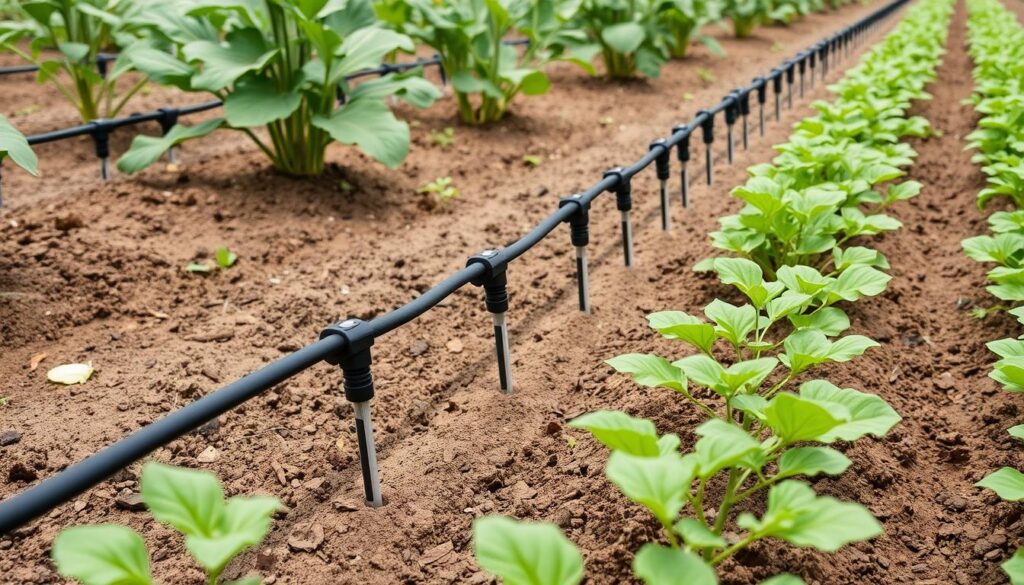
How to Implement Drip Irrigation
- Purchase a basic drip irrigation kit, which typically includes tubing, emitters, and connectors
- Plan your layout to ensure water reaches all plants efficiently
- Install the main line and connect it to your water source
- Add emitters near plant bases, using 1-2 emitters per plant depending on size
- Consider adding a timer to automate watering during optimal times (early morning or evening)
Pro Tip
Combine drip irrigation with mulch for maximum water conservation. The drip system delivers water directly to roots, while mulch prevents evaporation from the soil surface—a powerful combination that can reduce water needs by up to 70%.
3. Rainwater Harvesting: Capture Nature’s Free Resource
Rainwater harvesting is the practice of collecting and storing rainwater for later use in your garden. This ancient technique has become increasingly popular as water conservation awareness grows.
Why Rainwater Harvesting Works
Rain is a free, natural resource that’s often overlooked. By capturing rainwater from your roof, you can significantly reduce your reliance on municipal water supplies. Plus, rainwater is naturally soft and free from chemicals like chlorine, making it ideal for plants.
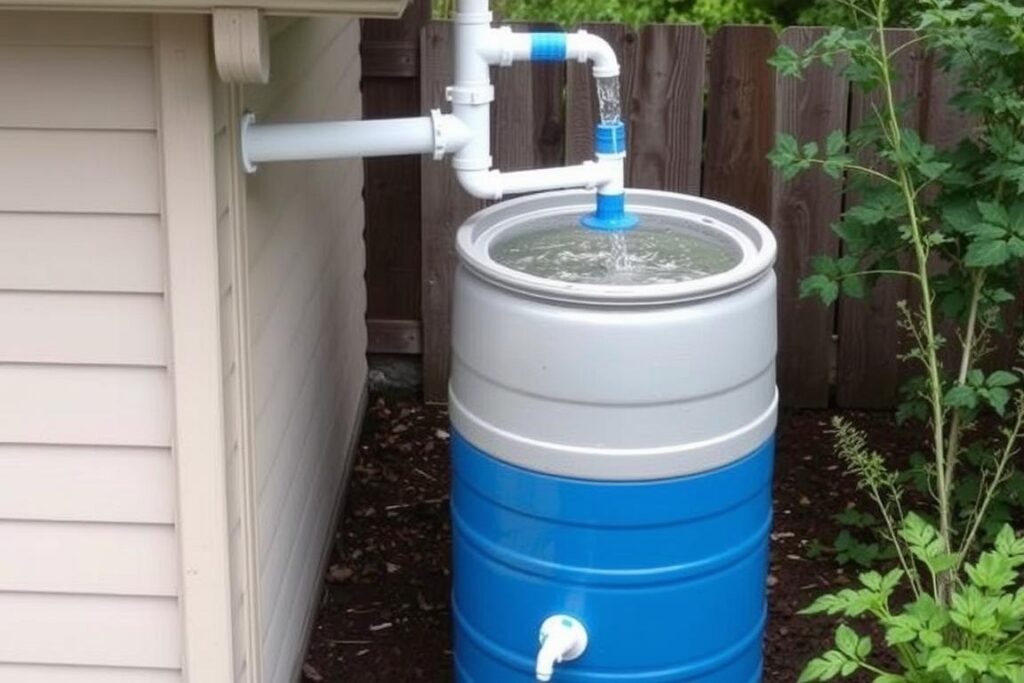
How to Implement Rainwater Harvesting
- Install rain barrels at downspouts around your home
- Ensure barrels have secure lids to prevent mosquito breeding
- Add overflow outlets to manage excess water during heavy rainfall
- Consider a first-flush diverter to prevent the initial, often dirty runoff from entering your barrel
- For larger properties, explore more extensive cistern systems
Pro Tip
A 1,000 square foot roof can collect approximately 600 gallons of water from just 1 inch of rainfall. Even a modest rain barrel system can capture enough water to significantly reduce your garden’s demand on treated water supplies.
4. Drought-Resistant Plants: Beauty with Less Water
One of the most effective long-term strategies for water conservation is selecting plants that naturally require less water. Drought-resistant plants have adapted to thrive with minimal irrigation once established.
Why Drought-Resistant Plants Work
These plants have evolved various mechanisms to survive with limited water, such as deep root systems, waxy leaf coatings, or small leaf surfaces that reduce transpiration. By choosing these naturally adapted species, you can maintain a beautiful garden while dramatically reducing water needs.
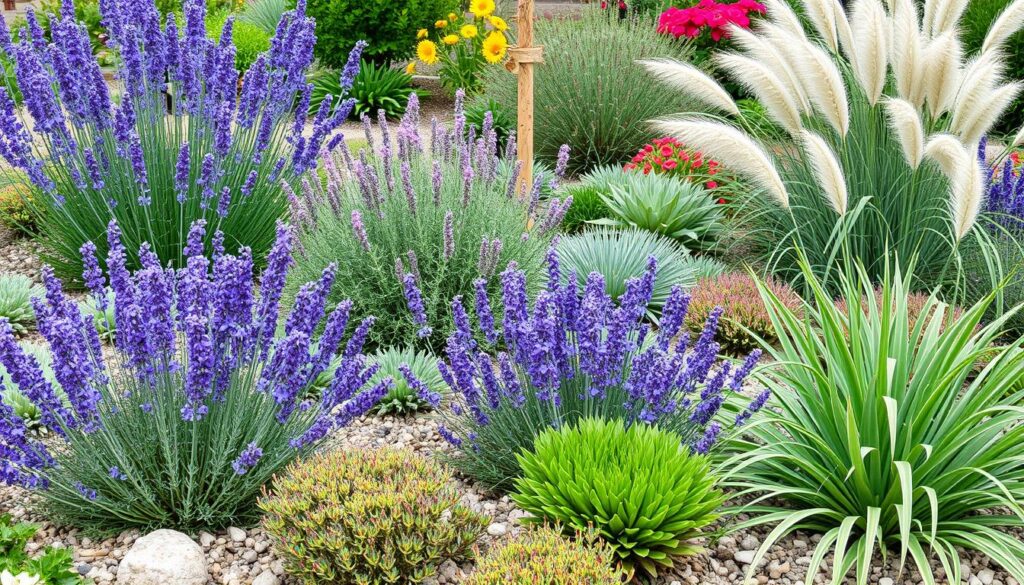
How to Implement Drought-Resistant Planting
- Research native plants for your region, as they’re naturally adapted to local rainfall patterns
- Look for plants with silvery, fuzzy, or waxy leaves—signs of drought adaptation
- Consider Mediterranean herbs like rosemary, thyme, and lavender, which thrive in dry conditions
- Explore ornamental grasses, succulents, and prairie plants for low-water landscaping
- Group plants with similar water needs together (known as hydrozoning)
Pro Tip
Even drought-resistant plants need regular watering during their establishment period (typically the first year). Once established, however, they’ll require significantly less supplemental irrigation than traditional garden plants.
5. Soil Amendment: Building Water-Efficient Foundations
The quality of your soil directly affects its ability to retain moisture. Amending your soil with organic matter creates a water-efficient foundation for your garden.
Why Soil Amendment Works
Organic matter acts like a sponge in soil, absorbing and holding water that would otherwise drain away. It also improves soil structure, allowing roots to penetrate more deeply and access moisture reserves during dry periods. Well-amended soil can hold up to 10 times more water than poor soil.
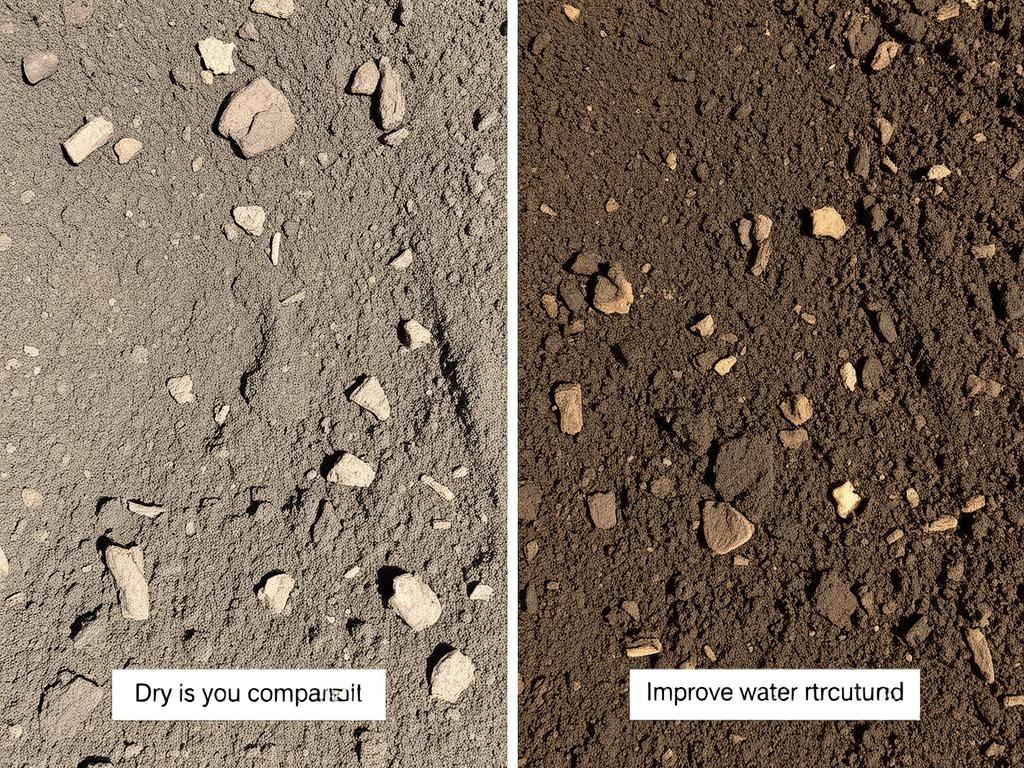
How to Implement Soil Amendment
- Add 2-3 inches of compost to garden beds annually
- Incorporate organic matter when preparing new planting areas
- Use compost tea as a soil drench to improve microbial activity
- Consider adding worm castings for additional organic matter and beneficial microbes
- For sandy soils, focus on adding materials that improve water retention
- For clay soils, add organic matter to improve drainage while maintaining moisture
Pro Tip
Avoid excessive tilling, which can destroy soil structure and beneficial organisms. Instead, use a gentle fork to incorporate amendments, or simply top-dress with compost and let earthworms do the work of integration.
6. Timing of Watering: When Matters as Much as How
The timing of your watering can significantly impact water efficiency. Watering at the right time of day can reduce evaporation and maximize absorption.
Why Timing Matters
When you water during hot, sunny hours, up to 30% of the water can be lost to evaporation before it even reaches plant roots. By contrast, watering during cooler parts of the day allows more water to soak into the soil and reach plant roots.
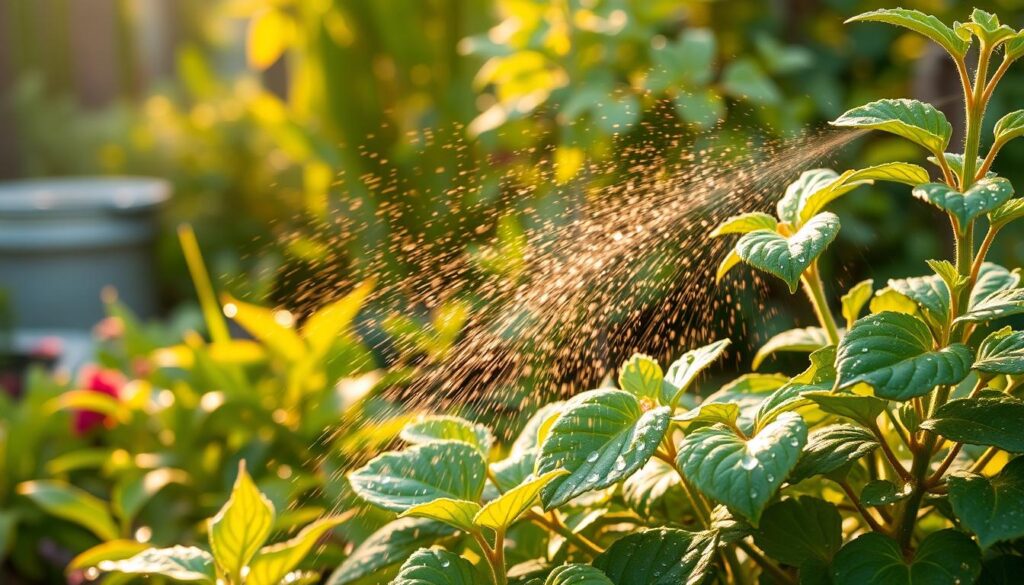
How to Implement Optimal Watering Timing
- Water early in the morning (4-9 AM) when evaporation rates are lowest
- If morning isn’t possible, water in the evening after the heat of the day has passed
- Avoid midday watering when evaporation is highest
- Water deeply but infrequently to encourage deep root growth
- Use a timer if you have trouble remembering optimal watering times
Pro Tip
Learn to read your plants for signs of water need rather than watering on a fixed schedule. Slight wilting in the afternoon that recovers by morning is normal for many plants and doesn’t necessarily indicate a need for water.
7. Hydrozoning: Strategic Plant Grouping for Water Efficiency
Hydrozoning is the practice of grouping plants with similar water needs together. This simple design strategy can dramatically improve water efficiency in your garden.
Why Hydrozoning Works
When plants with different water requirements are mixed together, you’re forced to water to satisfy the thirstiest plants, which means other plants receive more water than they need. By grouping plants with similar needs, you can target irrigation precisely where it’s needed.
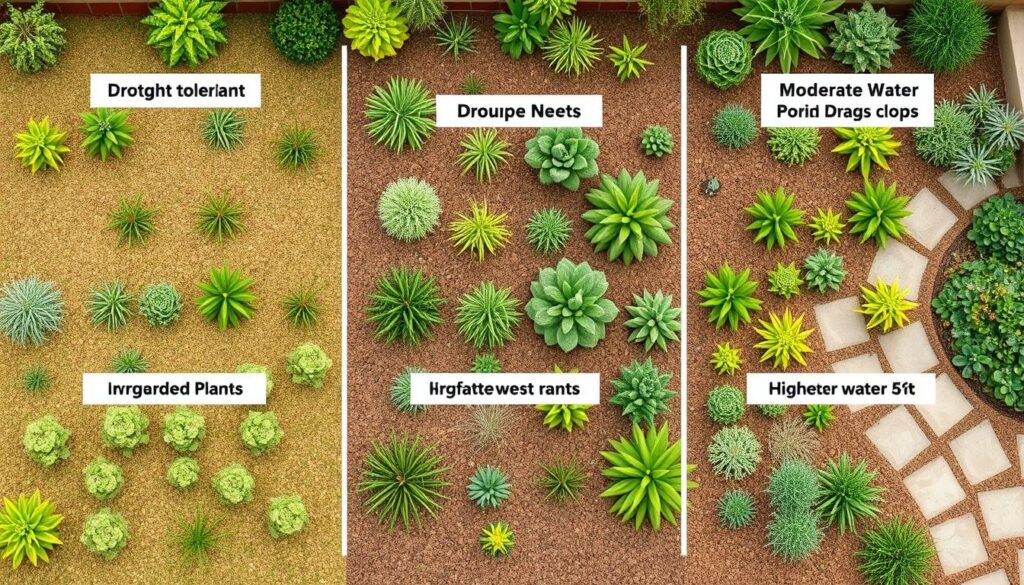
How to Implement Hydrozoning
- Create a garden map and divide it into zones based on water needs (low, medium, high)
- Research the water requirements of your plants and categorize them
- Relocate plants as needed to group them with others of similar water needs
- Install separate irrigation systems or zones for areas with different water requirements
- Place higher-water plants in naturally moister areas of your garden
Pro Tip
Consider your garden’s microclimates when planning hydrozones. Areas that receive afternoon shade, are protected from wind, or sit in natural depressions will naturally retain more moisture and are ideal for plants with higher water needs.
8. Using Ollas: Ancient Technology for Modern Water Conservation
Ollas (pronounced “oy-yahs”) are unglazed clay pots buried in the soil to provide slow, efficient irrigation directly to plant roots. This ancient technique dates back thousands of years but is experiencing a renaissance among water-conscious gardeners.
Why Ollas Work
The porous clay allows water to seep slowly into the surrounding soil based on plant demand. When soil is dry, more water seeps out; when soil is moist, less water is released. This responsive system delivers water directly to the root zone with minimal waste and evaporation.
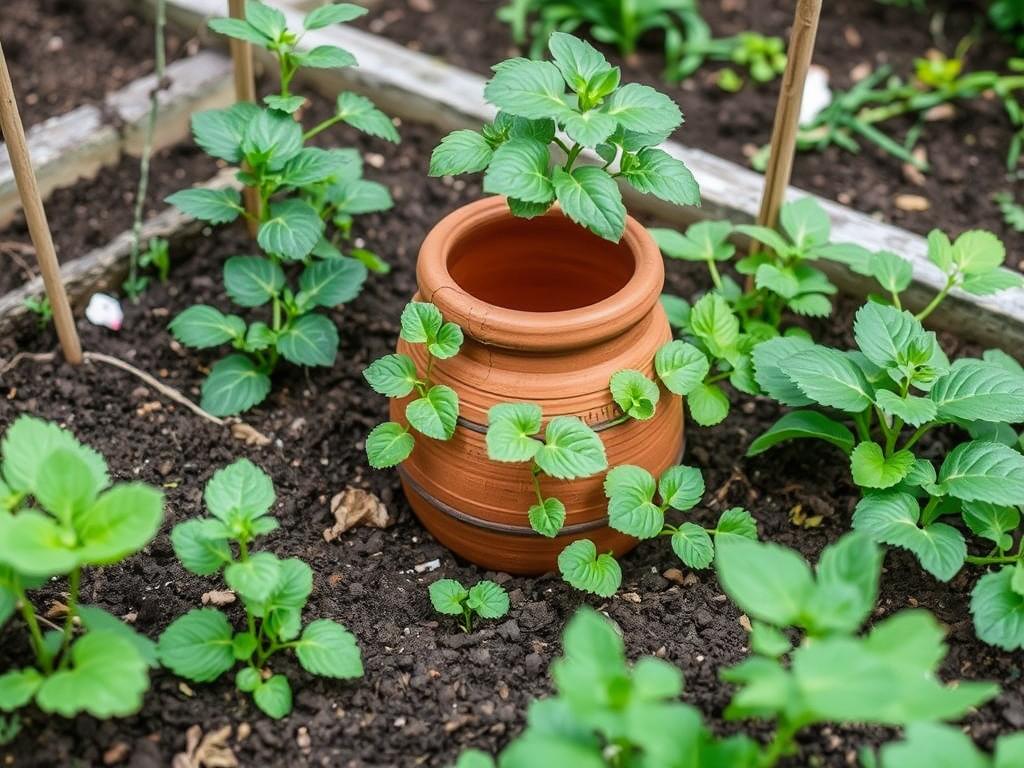
How to Implement Olla Irrigation
- Purchase purpose-made ollas or repurpose unglazed terracotta pots by plugging the drainage hole
- Bury ollas in garden beds with the neck extending above soil level
- Space ollas so their moisture fields overlap slightly (typically 2-3 feet apart)
- Fill ollas with water and cover the opening to prevent evaporation and mosquito breeding
- Refill as needed, typically every 3-7 days depending on weather and plant needs
Pro Tip
For a DIY approach, you can create ollas from unglazed terracotta pots. Simply seal the drainage hole with a cork or waterproof sealant, bury the pot, and leave the rim exposed for easy filling.
9. Xeriscaping: Comprehensive Water-Wise Landscaping
Xeriscaping is a comprehensive approach to landscaping that minimizes water use through thoughtful design, appropriate plant selection, and efficient irrigation. Despite common misconceptions, xeriscaping doesn’t mean creating a barren, cactus-filled yard—it can be lush and colorful.
Why Xeriscaping Works
By integrating multiple water-saving strategies into a cohesive design, xeriscaping can reduce landscape water use by 50-75%. It works with nature rather than against it, creating gardens that thrive with minimal supplemental irrigation.
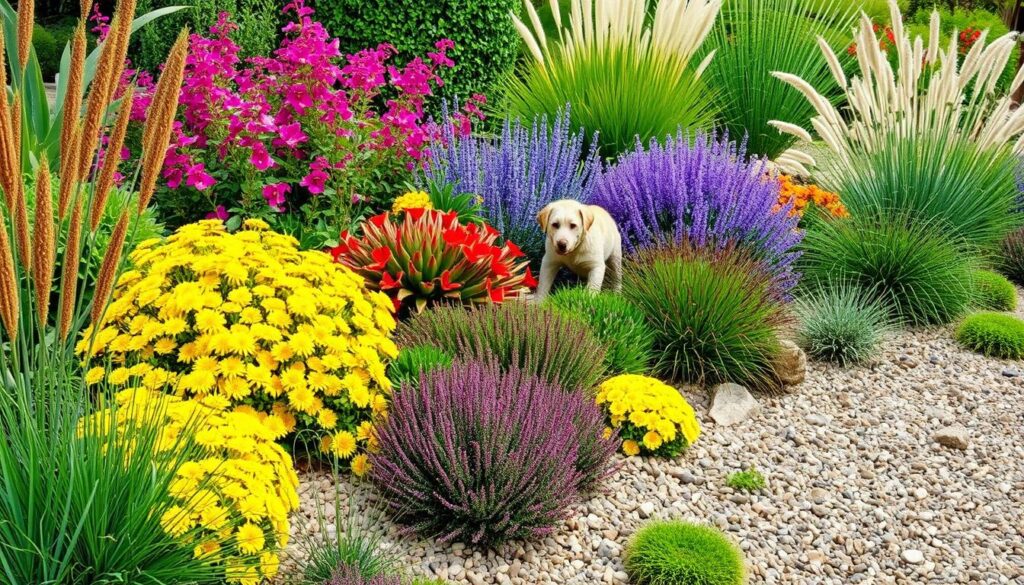
How to Implement Xeriscaping Principles
- Plan and design your landscape comprehensively, considering water use from the start
- Minimize turf areas, replacing non-functional lawn with drought-tolerant alternatives
- Select appropriate plants that thrive in your local climate with minimal irrigation
- Improve soil with organic matter to enhance water retention
- Apply mulch to all planting areas to reduce evaporation
- Install efficient irrigation systems like drip or soaker hoses
- Maintain your landscape properly to preserve water efficiency
Pro Tip
Start small with xeriscaping by converting one section of your garden at a time. This allows you to learn what works in your specific conditions and gradually expand your water-efficient landscape.
10. Greywater Systems: Recycling Household Water for Garden Use
Greywater refers to gently used water from bathroom sinks, showers, tubs, and washing machines. Instead of sending this water down the drain, greywater systems redirect it to your garden, providing a sustainable water source for plants.
Why Greywater Systems Work
The average household produces 30-40 gallons of greywater daily—water that’s perfectly usable for irrigation. By capturing and reusing this resource, you can significantly reduce your garden’s demand for fresh water while also reducing the burden on wastewater treatment facilities.

How to Implement Greywater Systems
- Start with simple systems like diverting washing machine water to the garden
- Use plant-friendly, biodegradable soaps and detergents
- Direct greywater to mulch basins rather than spraying it
- Avoid storing greywater for more than 24 hours
- Check local regulations, as greywater systems are subject to building codes in many areas
- Consider professional installation for more complex systems
Pro Tip
Even without a formal greywater system, you can practice water recycling by collecting shower warm-up water in a bucket or using cooking water (once cooled) to irrigate plants. These simple practices can save gallons of water daily.
Designing a Water-Smart Vertical Garden
Vertical gardening is ideal for space-limited areas and can be designed to be remarkably water-efficient. By implementing the right techniques, vertical gardens can thrive with minimal water input.
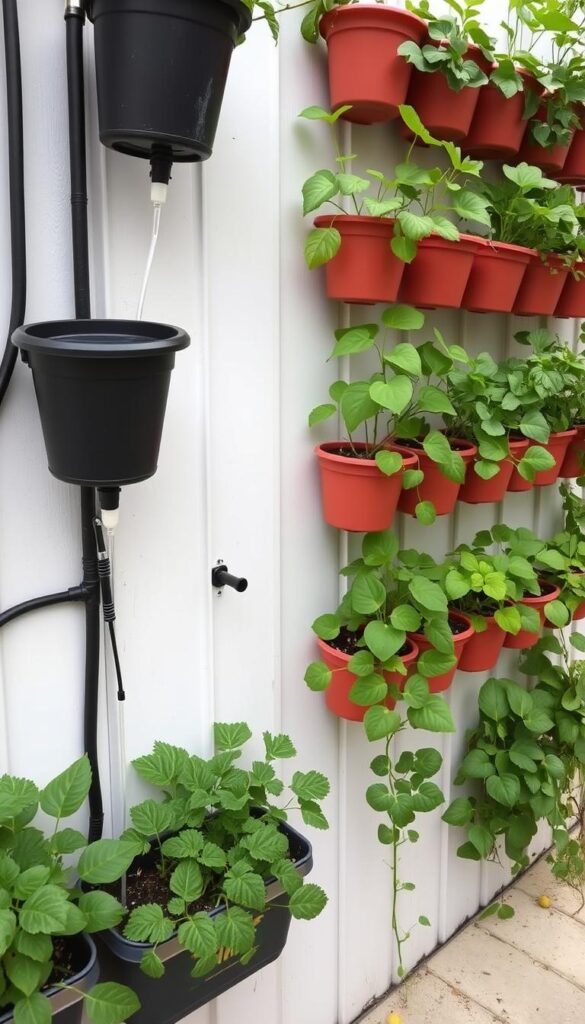
Key Strategies for Water-Efficient Vertical Gardens
- Use self-watering containers that reduce evaporation and provide consistent moisture
- Install drip irrigation systems that deliver water directly to plant roots
- Select drought-tolerant plants appropriate for vertical growing
- Create a moisture-retaining growing medium by adding water-absorbing polymers or coconut coir
- Position your vertical garden to minimize exposure to drying winds and afternoon sun
- Incorporate water catchment at the base to recycle runoff
Vertical gardens can actually be more water-efficient than traditional beds when designed properly. The key is creating systems where water moves downward through multiple plants before being collected and recycled, maximizing the utility of every drop.
Common Water-Wasting Mistakes to Avoid
Even gardeners with the best intentions sometimes fall into habits that waste water. Being aware of these common mistakes can help you further improve your garden’s water efficiency.
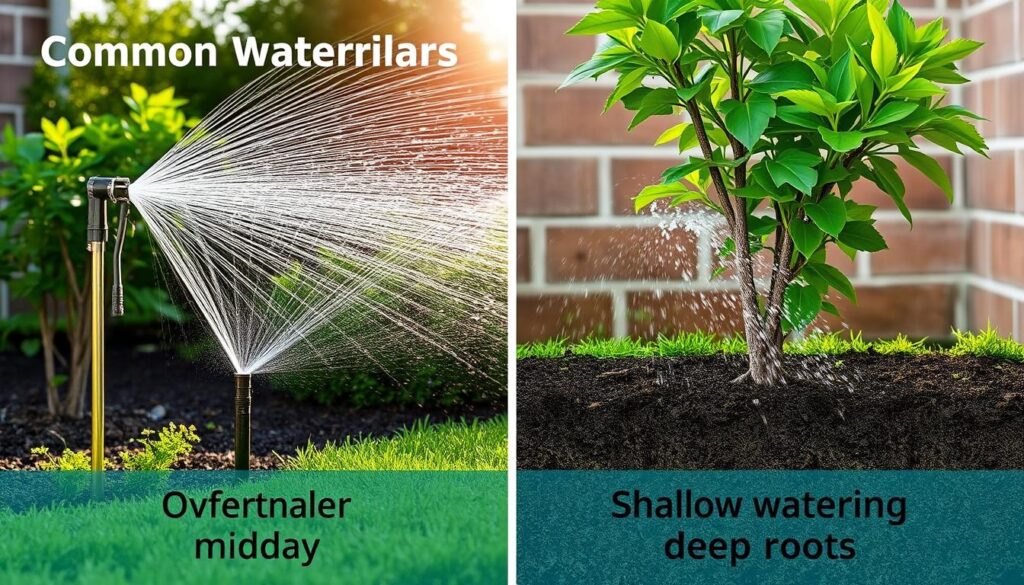
Water-Wasting Practices to Eliminate
- Shallow, frequent watering that encourages weak, surface-level root systems
- Watering on a fixed schedule regardless of weather conditions or plant needs
- Using overhead sprinklers during windy or hot periods when evaporation is highest
- Failing to fix leaky hoses, faucets, or irrigation systems
- Watering hardscapes like driveways and sidewalks along with plants
- Planting water-hungry species in areas that receive full, hot sun
- Neglecting to adjust irrigation systems seasonally as water needs change
By avoiding these common pitfalls and implementing the water-saving practices outlined in this guide, you can create a garden that thrives while using a fraction of the water typically required for traditional landscaping.
Conclusion: Every Drop Counts
Implementing water-saving gardening practices isn’t just about conservation—it’s about creating more resilient, sustainable gardens that can thrive even during challenging conditions. By adopting these ten essential techniques, you’ll not only reduce your water consumption but likely discover that your plants are healthier and more vibrant as a result.
Remember that you don’t need to implement all these practices at once. Start with the simplest strategies like mulching and proper watering timing, then gradually incorporate more advanced techniques as you become comfortable. Each step you take makes a difference in conserving our planet’s most precious resource.
Ready to Start Saving Water in Your Garden?
Download our free Water-Saving Garden Checklist to track your progress as you implement these sustainable practices. This printable guide helps you monitor water usage and plan your garden’s transformation step by step.
Will is a vertical gardening enthusiast and sustainable cultivation specialist with a passion for helping people grow fresh food in small spaces and dry climates. With years of hands-on experience testing smart irrigation systems, optimizing urban gardens, and exploring eco-friendly solutions, this author shares clear, practical tips to turn any corner into a productive garden. Whether on a sunny balcony or in a compact backyard, Will helps readers save water, maximize space, and enjoy healthy harvests year-round. When not tending to his plants, you’ll find him sipping herbal tea and sketching ideas for new sustainable projects.

